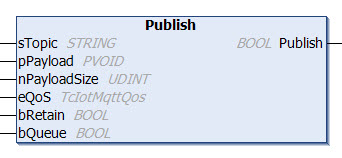Publish

This method is called once, in order to send a message to the broker.
Syntax
METHOD Publish : BOOL
VAR_IN_OUT
sTopic : STRING; // topic string (UTF-8) with any length (attend that MQTT topics are case sensitive)
END_VAR
VAR_INPUT
pPayload : PVOID;
nPayloadSize : UDINT;
eQoS : TcIotMqttQos; // quality of service between the publishing client and the broker
bRetain : BOOL; // if TRUE the broker stores the message in order to send it to new subscribers
bQueue : BOOL; // for future extension
END_VAR
 Return value
Return value
Name | Type | Description |
|---|---|---|
Publish | BOOL | The method returns the return value TRUE if the call was successful. |
 Inputs
Inputs
Name | Type | Description |
|---|---|---|
sTopic | STRING | Topic of the MQTT message |
pPayload | PVOID | Address for the payload of the MQTT message |
nPayloadSize | UDINT | Size of the payload in bytes |
eQoS | TcIotMqttQos | "Quality of Service" |
bRetain | BOOL | If bRetain is TRUE, the broker stores the message in order to make it available to subsequent subscribers. |
bQueue | BOOL | Reserved parameter that can always be given the value FALSE. |
Possible errors are output at the outputs bError and hrErrorCode of the function block instance.
 | Message payload formatting Note that the data type and the formatting of the content must be known to the sender and receiver side, particularly when binary information (alignment) or strings (with or without zero termination) are sent. |
 | Strings in UTF-8 format The variables of type STRING used here are based on the UTF-8 format. This STRING formatting is common for MQTT communication as well as for JSON documents. In order to be able to receive special characters and texts from a wide range of languages, the character set in the Tc3_IotBase and Tc3_JsonXml libraries is not limited to the typical character set of the data type STRING. Instead, the Unicode character set in UTF-8 format is used in conjunction with the data type STRING. If the ASCII character set is used, there is no difference between the typical formatting of a STRING and the UTF-8 formatting of a STRING. Further information on the UTF-8 STRING format and available display and conversion options can be found in the documentation for the Tc2_Utilities PLC library. |